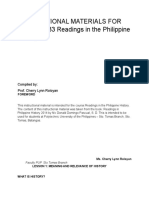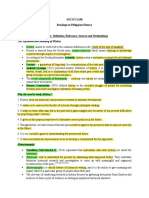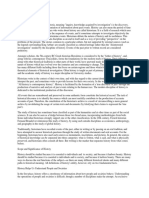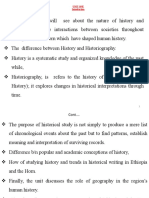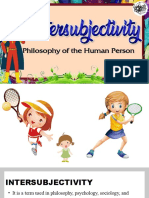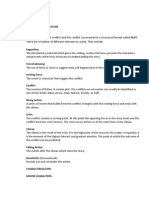0 ratings0% found this document useful (0 votes)
49 viewsTheories RPH
Theories RPH
Uploaded by
elaineThis document discusses what history is and the importance of studying it. It defines history as more than just lists of facts - it is understanding the ideas and realities that have shaped societies over time. Studying history allows us to understand how the past has influenced the present and can help address current issues. The document also discusses the different types of sources historians use - primary sources created by eyewitnesses and secondary sources that interpret and analyze primary sources. Primary sources include things like photographs, maps, and oral histories, while secondary sources are books and articles that discuss and reference primary sources.
Copyright:
© All Rights Reserved
Available Formats
Download as DOC, PDF, TXT or read online from Scribd
Theories RPH
Theories RPH
Uploaded by
elaine0 ratings0% found this document useful (0 votes)
49 views2 pagesThis document discusses what history is and the importance of studying it. It defines history as more than just lists of facts - it is understanding the ideas and realities that have shaped societies over time. Studying history allows us to understand how the past has influenced the present and can help address current issues. The document also discusses the different types of sources historians use - primary sources created by eyewitnesses and secondary sources that interpret and analyze primary sources. Primary sources include things like photographs, maps, and oral histories, while secondary sources are books and articles that discuss and reference primary sources.
Original Description:
This is description
Copyright
© © All Rights Reserved
Available Formats
DOC, PDF, TXT or read online from Scribd
Share this document
Did you find this document useful?
Is this content inappropriate?
This document discusses what history is and the importance of studying it. It defines history as more than just lists of facts - it is understanding the ideas and realities that have shaped societies over time. Studying history allows us to understand how the past has influenced the present and can help address current issues. The document also discusses the different types of sources historians use - primary sources created by eyewitnesses and secondary sources that interpret and analyze primary sources. Primary sources include things like photographs, maps, and oral histories, while secondary sources are books and articles that discuss and reference primary sources.
Copyright:
© All Rights Reserved
Available Formats
Download as DOC, PDF, TXT or read online from Scribd
Download as doc, pdf, or txt
0 ratings0% found this document useful (0 votes)
49 views2 pagesTheories RPH
Theories RPH
Uploaded by
elaineThis document discusses what history is and the importance of studying it. It defines history as more than just lists of facts - it is understanding the ideas and realities that have shaped societies over time. Studying history allows us to understand how the past has influenced the present and can help address current issues. The document also discusses the different types of sources historians use - primary sources created by eyewitnesses and secondary sources that interpret and analyze primary sources. Primary sources include things like photographs, maps, and oral histories, while secondary sources are books and articles that discuss and reference primary sources.
Copyright:
© All Rights Reserved
Available Formats
Download as DOC, PDF, TXT or read online from Scribd
Download as doc, pdf, or txt
You are on page 1of 2
What is History?
ancient castles, the prized possessions of autograph
To make sense of history, it is necessary to first collectors, the records. of parish churches, etc. Having some
understand what it is all about. Many people think that subject in mind, with more or less definite delimitation
history is merely lists of names, dates, places, and important" of the persons, areas, times, and functions
events. However, history or the study of history is more than It is from historical sources that our history is studied
just knowing and memorizing facts. and written. But in analyzing them, several methodologies
It is a historian's duty to draw insights from the ideas and and theories were used by historians to properly study
realities that have shaped the lives of men and women and history and glean from the sources what is, for them, a
the society. And in understanding these ideas, a historian (or, proper way of writing history to enhance and disseminate
in fact, a student of history) can comprehend how situations national identity.
happened, identify their elements, and think of how these Primary Sources
situations can solve today's predicaments and help plan for Primary sources are materials produced by people or
the future. groups directly involved in the event or topic being studied.
These people are either participants or eyewitnesses to the
The study of history, therefore, is the study of the event. These sources range from eyewitness accounts,
beliefs anddesires, practices, and institutions of human diaries, letters, legal
beings. documents, official documents (government or private), and
With this definition, history becomes an active factor even Formally, here are eight examples of these primary
inthe study of Philippine society. It also includes a look into sources:
thedevelopment of Philippine culture through time especially 1. Photographs that may reflect social conditions of
with the influences of the colonial period that would historical realities and everyday life
eventually shape the present Philippine identity. 2. Old sketches and drawings that may indicate the conditions
of life of societies in the past
Why Study History? .3. Old maps that may reveal how space and geography
An examination of the past can tell us a great deal were used to emphasize trade routes, structural build-
abouthow we came to be who we are. It mean looking at the up, etc.
roots ofmodern institutions, ideas, values, and problems. 4. Cartoons for political expression or propaganda
Looking at the past teaches us to see the world 5.Material evidence of the prehistoric pact like cae
through different eyesappreciating the diversity of human drawings, old syllabaries, and ancient writings
perceptions, beliefs, and cultures. Different andlor new 6. Statistical tables, graphs, and charts
perspectives will enable us to analyze critically the present 7.Oral history or recordings by electronic means of
contexts of society and beings. accounts of eyewitnesses or participants; the recordings
are then transcribed and used for research.
The Meaning of "History"
8. Published and unpublished primary documet
The English word history is derived from the Greek
eyewitness accounts, and other written sources.
noun “istoia”, meaning learning. As used by the Greek
philosopher Aristotle, history meant a systematic account of a Secondary Sources
set of natural phenomena, whether or not chronological Gottschalk simply defines secondary sources as "the
factoring was a factor in the account... In the course of time, testimony of anyone who is not an eyewitness--t that is of
however, the equivalent Latin word scientia (English, science) one who was not present at the event of which he tells".
came to be used more These are books, articles, and scholarly journals that had
regularly to designate non-chronological systematic accounts interpreted primary sources or had used them to discuss
By its most common definition, the word history certain subjects of history.
now means, "the past of mankind.".
What are Sources?
In his work, Understanding History, Gottschalk
(195o) discusses the importance of sources for the historian's
work:
The historian, howvever, has to use manymaterials
that are not in books. Where these are archeological,
epigraphical, on numismatical materials, he has to depend
largely on museumns. Where there are official records, he
may have to search for them in archives, courthouses,
government libraries, etc. Where there are private papers not
available in official collections, he mayhave to hunt among
.
the papers of business houses, the muniment rooms of
.
You might also like
- Archaeology and Photography Time, Objectivity and Archive (Lesley McFadyen Dan Hicks (Editors) ) (Z-Library)Document265 pagesArchaeology and Photography Time, Objectivity and Archive (Lesley McFadyen Dan Hicks (Editors) ) (Z-Library)raulNo ratings yet
- Chapter 1 Meaning and Relevance of HistoryDocument6 pagesChapter 1 Meaning and Relevance of HistoryCASIMERO, KENJI B.No ratings yet
- Sherrill Grace - Margaret Atwood - Language, Text and System-University of British Columbia Press (1983)Document169 pagesSherrill Grace - Margaret Atwood - Language, Text and System-University of British Columbia Press (1983)Monika KosaNo ratings yet
- SPJAT SAMPLE PAPER No 2Document13 pagesSPJAT SAMPLE PAPER No 2Vita Nur AryatiNo ratings yet
- Conceptual Framework For Artmaking PDFDocument10 pagesConceptual Framework For Artmaking PDFPatrícia NogueiraNo ratings yet
- Readings in The Philippine History L1-3Document11 pagesReadings in The Philippine History L1-3charity villanuevaNo ratings yet
- Readings in Philippine HistoryDocument97 pagesReadings in Philippine HistoryAnali BarbonNo ratings yet
- RPH LESSONS FORM PPTDocument2 pagesRPH LESSONS FORM PPTshakikentoNo ratings yet
- Chapter 1 and 2 RPHDocument32 pagesChapter 1 and 2 RPHJimwell HilarioNo ratings yet
- Readings in Philippine HistoryDocument7 pagesReadings in Philippine HistoryMary MAy Matabang100% (1)
- RPH Lesson 1 2Document27 pagesRPH Lesson 1 2San Michelle MoralesNo ratings yet
- Lesson 1Document5 pagesLesson 1Zyra BalderamaNo ratings yet
- Unit 1: Interpreted Primary SourcesDocument1 pageUnit 1: Interpreted Primary SourcesKyla Marie PacubasNo ratings yet
- Lesson 1:: Meaning of HistoryDocument13 pagesLesson 1:: Meaning of HistorykillsamonteNo ratings yet
- Introduction To RPHDocument6 pagesIntroduction To RPHJPNo ratings yet
- Module 1: Learning History: Context Analysis Considers The Time and Place The Historical Document Was Written AsDocument45 pagesModule 1: Learning History: Context Analysis Considers The Time and Place The Historical Document Was Written AsRaffy VeraNo ratings yet
- ReviewersDocument18 pagesReviewersjamaicacastro82No ratings yet
- RPH Intro 1 2 3Document131 pagesRPH Intro 1 2 3Papa, Jeriemar S.No ratings yet
- Ass 1 RPHDocument9 pagesAss 1 RPHWilson NavarroNo ratings yet
- Lesson 1: - The Meaning of HistoryDocument5 pagesLesson 1: - The Meaning of HistoryJean Carmelette BalalloNo ratings yet
- Hist 102Document75 pagesHist 102yirgalemle ayeNo ratings yet
- Definition of HistoryDocument6 pagesDefinition of HistoryJaylord MedinaNo ratings yet
- GE8 Chapter 1 Converted 2Document61 pagesGE8 Chapter 1 Converted 2Maria Jane PerezNo ratings yet
- GEED 10033 - Readings in Phil History-Lesson 1Document11 pagesGEED 10033 - Readings in Phil History-Lesson 1Leanna Mae TupazNo ratings yet
- Reviewer in RPHDocument57 pagesReviewer in RPHEzraeli DomingoNo ratings yet
- RPH ReviewerDocument5 pagesRPH Reviewer20mintchocologistNo ratings yet
- GE 2 RPH Module 1Document5 pagesGE 2 RPH Module 1Freddie ColladaNo ratings yet
- UNIT 1. Module 1 & 2Document13 pagesUNIT 1. Module 1 & 2Trishia Mae Gregorio BelenNo ratings yet
- GE112 2023 2024 1st Sem ModuleDocument61 pagesGE112 2023 2024 1st Sem ModuleAgri BasketNo ratings yet
- Gec 2Document8 pagesGec 2Anjelika ViescaNo ratings yet
- Lecture 1 HISTORYDocument25 pagesLecture 1 HISTORYArlan DayligNo ratings yet
- Chapter 1Document11 pagesChapter 1Aljhon Sombillo TolentinoNo ratings yet
- Notes For HistoryDocument2 pagesNotes For HistoryHannah Marie CaringalNo ratings yet
- Chapter 1-3 With MAPSDocument88 pagesChapter 1-3 With MAPSMilkway NguNo ratings yet
- Common Course FinalDocument62 pagesCommon Course FinalLetaNo ratings yet
- Book 1Document4 pagesBook 1lucy faithNo ratings yet
- Topic: The Meaning and Relevance of History Definition, Issues, Sources, & MethodologyDocument27 pagesTopic: The Meaning and Relevance of History Definition, Issues, Sources, & MethodologyRose Vee PaynoNo ratings yet
- Worksheet Meaning of HistoryDocument9 pagesWorksheet Meaning of HistoryXhennNo ratings yet
- Gerph 1Document10 pagesGerph 1ARBOLEDA, LADY CHRSTINE C.No ratings yet
- Lesson 1 History Sources of Historical Data CriticismDocument58 pagesLesson 1 History Sources of Historical Data CriticismErica MorpeNo ratings yet
- RPH YrishDocument7 pagesRPH YrishJohn Lloyd Artuz EnriquezNo ratings yet
- Readings in Philippine HistoryDocument23 pagesReadings in Philippine Historyangelynjoyce00No ratings yet
- Concept of HistoryDocument6 pagesConcept of HistoryLouwell DeriadaNo ratings yet
- Readings On Philippine History HandoutDocument170 pagesReadings On Philippine History HandoutMariel AttosNo ratings yet
- Communication TheoryDocument89 pagesCommunication Theoryshivam tyagiNo ratings yet
- Class XI NotesDocument13 pagesClass XI NotesTshewang DendupNo ratings yet
- The Meaning of History, Sources of Historical Data and Historical Criticism (Notes)Document7 pagesThe Meaning of History, Sources of Historical Data and Historical Criticism (Notes)Ebab YviNo ratings yet
- LESSON NO: 1 (3hours) Title: Learning HistoryDocument28 pagesLESSON NO: 1 (3hours) Title: Learning HistoryJeya Plays YT100% (1)
- RPH (Notes)Document17 pagesRPH (Notes)Erica BalandayNo ratings yet
- W1 Chapter 1: Meaning and Relevance of HistoryDocument8 pagesW1 Chapter 1: Meaning and Relevance of HistoryMari DelizoNo ratings yet
- Module in Readings in Philippine History LESSON 1: History, Sources and Historical DataDocument7 pagesModule in Readings in Philippine History LESSON 1: History, Sources and Historical DataMica Ella De LeonNo ratings yet
- Module 1Document24 pagesModule 1christiannnoochoa24No ratings yet
- H - Module 1 Readings in Philippine HistoryDocument20 pagesH - Module 1 Readings in Philippine HistoryMark TayagNo ratings yet
- Lesson 1: History: Introduction and Historical Sources A. DefinitionDocument6 pagesLesson 1: History: Introduction and Historical Sources A. DefinitionKim Franzel AntonioNo ratings yet
- Historical Sources: Primary Sources: Material ObjectsDocument8 pagesHistorical Sources: Primary Sources: Material ObjectsBea KulinNo ratings yet
- Ge02 Reviewer PrelimsDocument9 pagesGe02 Reviewer PrelimsJamaica MendenillaNo ratings yet
- Chapter/ Module 1: Learning HistoryDocument8 pagesChapter/ Module 1: Learning Historyabc xyzNo ratings yet
- Eth and The HornHistory Common Course, Lecture Note 3-1Document109 pagesEth and The HornHistory Common Course, Lecture Note 3-1Aschalew AyeleNo ratings yet
- Reading in Philippine History: Lesson 1Document13 pagesReading in Philippine History: Lesson 1AMOLAR, ROSSEL JOY C.No ratings yet
- Chapter One 1Document37 pagesChapter One 1Gerbeba JaletaNo ratings yet
- RIPH ReviewerDocument26 pagesRIPH ReviewerAbigail VillalvaNo ratings yet
- Chapter 1 Meaning and Relevance of HistoryDocument23 pagesChapter 1 Meaning and Relevance of HistoryNicko EugenioNo ratings yet
- FS 1 - Module 3Document14 pagesFS 1 - Module 3Stephanie Shane ArellanoNo ratings yet
- HS11L2 - Montgomery-1998 PDFDocument25 pagesHS11L2 - Montgomery-1998 PDFmoni_john_1No ratings yet
- William Atkinson - The Secret of SuccessDocument43 pagesWilliam Atkinson - The Secret of Successanon-94983100% (10)
- Philosopher Activity#2Document1 pagePhilosopher Activity#2DarylNo ratings yet
- Damian Valdez (Auth.) - German Philhellenism - The Pathos of The Historical Imagination From Winckelmann To Goethe-Palgrave Macmillan US (2014)Document262 pagesDamian Valdez (Auth.) - German Philhellenism - The Pathos of The Historical Imagination From Winckelmann To Goethe-Palgrave Macmillan US (2014)Eric E. Ríos Minor100% (1)
- SCITECH 4A - Patulot, Carl Joshua H.Document1 pageSCITECH 4A - Patulot, Carl Joshua H.Jushua PatulotNo ratings yet
- Sakaguchi AngoDocument74 pagesSakaguchi AngoP GNo ratings yet
- Uts ModuleDocument135 pagesUts ModuleKaitlinn Jamila AltatisNo ratings yet
- General Problems To The Stylistics OutlineDocument255 pagesGeneral Problems To The Stylistics OutlineMuhammad Sajid Us Salam67% (3)
- Torture Thesis StatementDocument8 pagesTorture Thesis Statementclaudiashaharlington100% (2)
- Sartori - What Is PoliticsDocument23 pagesSartori - What Is PoliticsPetra FryckovaNo ratings yet
- Oswald Spengler Prophet of World Chaos. - Rudolf Steiner - 2018 - Anna's ArchiveDocument46 pagesOswald Spengler Prophet of World Chaos. - Rudolf Steiner - 2018 - Anna's ArchiveDušan JovanovićNo ratings yet
- Reading SkillsDocument28 pagesReading SkillsBaseer AhmadNo ratings yet
- Full download Digital Marketing strategy: An integrated approach to online marketing Simon Kingsnorth pdf docxDocument25 pagesFull download Digital Marketing strategy: An integrated approach to online marketing Simon Kingsnorth pdf docxaynursapalo100% (2)
- Golden & Corbett (1990) Introduction To The Rhetoric of Blair, Campbell and Whatley (243-260)Document20 pagesGolden & Corbett (1990) Introduction To The Rhetoric of Blair, Campbell and Whatley (243-260)Philip BeardNo ratings yet
- 5. On the Idea of the Secondary World in Susanna Clarke’s PiranesiDocument25 pages5. On the Idea of the Secondary World in Susanna Clarke’s Piranesicrespomarc23No ratings yet
- 4 Hall (1997)Document66 pages4 Hall (1997)Margareth Laska de Oliveira100% (1)
- Get Applied Psychology for Social Work Second Edition Ewan Ingleby free all chaptersDocument60 pagesGet Applied Psychology for Social Work Second Edition Ewan Ingleby free all chaptersfalcidomkefd100% (15)
- Philosophy ReportDocument55 pagesPhilosophy Reportmae amor cedenioNo ratings yet
- RW 11 DiamadaDocument9 pagesRW 11 DiamadaRunaliza CamposNo ratings yet
- UntitledDocument4 pagesUntitledMuhammad EssaNo ratings yet
- Detailed Lesson PlanDocument6 pagesDetailed Lesson PlanJoseph ConchaNo ratings yet
- Ge6 Study Guide 1Document6 pagesGe6 Study Guide 1PammieNo ratings yet
- The Goodman Battery Part 1Document21 pagesThe Goodman Battery Part 1Olivia MNo ratings yet
- Why The Novel Matters - Literary AnalysisDocument4 pagesWhy The Novel Matters - Literary AnalysisChaitanya Singh Chouhan100% (2)
- Background Elements of LiteratureDocument5 pagesBackground Elements of LiteratureOlaybar EsoNo ratings yet























